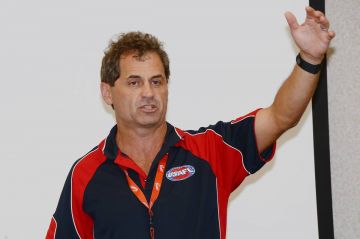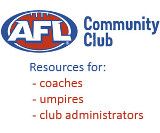Ryan: Future Relies on Coaching, Recruiting, and Schedule
|
|
Picture it. Years from now, a crowd of 100,000 people gathered at the MCG under the lights to watch some of the best football players in the world do battle. A team of some of the best Australian footballers, versus… the Americans. Only the MCG is not the MCG; Its a stadium built specifically for Australian Football here in the US.
A long way off, yes. But that is USAFL President Denis Ryan’s vision. A grand vision of what Aussie Rules in America can be. To get there, Ryan outlined a number of visions and initiatives for the short term at the USAFL Administrators conference during USAFL Nationals weekend in Dublin, Ohio.
Much of this path to the future, in Ryan’s eyes, was shaped based on the results of the 2014 International Cup, a tournament that saw the US Revolution come in a disappointing eighth place. Among the issues, he said, was the amount of games played by USAFL teams, the standard of coaching, and the ability to recruit better athletes for American clubs.
Coaching: No One Left Behind
Ryan stated that Australian coaches, specifically those who have not been home in years, are not able to keep up with changes in methodology and philosophy and are being left behind. He pointed to the fact that AFL coaching staffs, once limited to just a handful of coaches, now have specialists that help away from the oval, including physical therapists, sports scientists, and trainers.
“American sports can learn from AFL clubs,” Ryan stated. “Leagues such as the NFL and NBA see themselves as the epitome, and don’t feel they have anything to learn from below them.”
To help rectify the gap in coaching, all USAFL coaches will be required to, from the 2015 season, complete their AFL Level 1 Coaching accreditation via an online course approved by the AFL. “There are no excuses to not get accredited,” Ryan told the conference.
Though not required as of yet, both Ryan and the league will encourage coaches to try for their Level 2 accreditation as well. Ideally, this will be for coaches, both Australian and American, who will be staying in the US and with their USAFL clubs for the long term.
“We want a free flow of information between us and the AFL,” Ryan added. “Australians, in particular, want to come over here because the economy is right. We want to bring the ‘right’ Australians into the league, and to help our clubs grow. We don’t want folks coming here looking for a vacation. We want to build for the future.”
Recruiting: Taking Footy to the Schools
That includes players, as well, and the recruiting effort that the league will undertake from this year is aimed at getting both younger Aussies and Americans into the game. The biggest charge will be made at the college level, beginning with the USAFL College 10’s tournament. The first edition of the school competition will be on November 22nd in College Station, Texas.
“Growth into colleges and universities is very important,” Ryan said. “These kids are 22 years old when they graduate, they spread all over the country, taking the game with them (or joining existing teams) and they’ll have about ten more years in which to play.”
The key to bringing younger aged (high school and below) players into the sport lies in one entity: scholarships. Ryan suggested that parents want their children to play sports where the financial burden of school is alleviated, and Australian Football needs to attain the status to allow them a chance to do that. He added, however, that, footy would need to be a club sport, before gaining full varsity status under the auspices of the NCAA.
College footy is not a new idea. A decade ago, Vanderbilt, North Carolina, and North Carolina State all had formed club teams, but outside of each other, they ended up playing USAFL clubs instead. “I know for a fact,” Ryan quipped, “that at 20-23 years of age, you don’t want to be playing against 40 year olds. And that’s exactly what happened. We want to build a competition for their age group.”
That competition would look to be a mixture of American newbies and Australian students. Americans would be learning the game through the “AFL for Beginners” course developed by Advisory Board director Tony Fairhead, while the clubs would target Aussies on study abroad coming into the school and help mentor new players.
“We want Australian students seeking out schools in the US because of their footy scholarships,” Ryan stated. “We want to work with the International departments at each school, provide them with some value and help them use that as a recruiting tool.”
Metro and Co-ed Touch Footy: Paths to Progress
Speaking of recruiting tools, Ryan also proposed the Metro and co-ed non-contact games standardized and made into stepping stones for both men and women to play on their clubs’ full contact sides. The proposal would have full contact Metro matches set at 10-a-side, while non-contact games would feature 9’s play.
“We have a duty of care to all of our players, and there needs to be a distinction in the two types of games,” Ryan explained. “If a player thinks that they’re playing non-contact and they end up getting injured after getting tackled, that could be a bad situation for both the league and the sport here.”
As far as structure is concerned, Ryan pointed to the Golden Gate and Southern California metro systems as the most effective starting points for what he’d like to see the metro program achieve.
“Right now, metro leagues are 2-4 teams, games are played with anywhere from 8-16 players on differing sizes of grounds with variable rules,” Ryan said. “What ends up happening is that, when it’s time to play 18-a-side matches, clubs barely get enough to field a full side, and players get complacent because they know they’ll have a spot on the full side.
“With metro leagues of six, eight, or even ten teams, the first side is now a carrot for players to take metro seriously, while using the smaller field and team sizes to get more involved. With 10-a-side, it’s easier to get to the goal of a ten team league.”
Other benefits of the 10-a-side format would be adaptability of field locations – Tulsa and St. Petersburg plan to play in baseball stadiums next season – and that the game would be more attractive for television audiences. Ryan suggested that the smaller field and smaller team number would make it easier for American audiences to pick up at first over the 18-a-side AFL matches that are broadcast.
A number of incentives were mooted from the league in order to entice teams to grow. The biggest of which would be that leagues of six teams or more would be eligible for USAFL points when it comes to Nationals eligibility.
“We need our metro programs, and our clubs in general, to be stronger,” Ryan said. “I believe that you are only as strong as your weakest clubs. It has been great to see clubs like Houston, Des Moines, and Sacramento getting stronger, but other clubs such as Baton Rouge, Atlanta, and San Diego are barely staying alive.”
One way to increase that vitality, Ryan suggested, was a radical reformation of the USAFL schedule.
A New Take on the USAFL Schedule
“It’s clear,” he said, “that we simply don’t play enough games.” Ryan pointed to the fact that most of the players on the top teams, such as Ireland, Papua New Guinea, and New Zealand, play in Australia at least half the season.
“Currently, our season begins in early spring – as early as January depending on the weather – and goes all the way until Nationals in October. Teams play a handful of full and metro matches, go into a holding pattern during the summer, and then go into a bit of a cram session to get more games in before Nationals.”
The reason for the scheduling, Ryan explained, was that it followed the AFL schedule, and it allowed AFL dignitaries to visit Nationals a week after visiting the Ontario AFL final weekend.
“It’s an impractical reason for us to have our season set up that way,” Ryan said. “It’s not an American sports season. It doesn’t fit with a school-based season, it’s too long, it’s too spread out, and there is a drop off in summer when it gets hot and players go on vacation.” He emphasized the temperature issue as part of the league’s duty of care, pointing to the number of heat-related fatalities surrounding American football and how the current culture of denial perpetuated by the NFL exacerbates the risks of playing in heat.
“We don’t want one of our players dying because of heat exhaustion,” Ryan stated. “If that happens, the league may die with it.”
Ryan’s alternative schedule would see the season split into two parts, fall and spring. The fall season would go from September to November and be completely focused on metro and touch leagues. During the fall season, each region would host a 10’s championship, as well.
“Having the season start in fall would allow us to make full use of the AFL Grand Final as a recruiting tool,” he explained. “Clubs can bring people in on Friday night to see the game, then take them to the ground the next morning and get them involved straight away.”
The move would also allow Australian players and coaches to come over on visas and act as development coaches. It would also allow American players to go over during the heart of the Australian season and play there, as well. It would also possibly create a reward system for AFL Development Officers, whose workload is diminished at this time of year in Australia, who could come to the US and help develop our clubs.
“We need to create a trade of people and information both ways across the Pacific,” Ryan explained. “It will be an economic boost for Australia and their game. It will become big business.”
After a break for the winter, the season would resume in April and go through until the end June. The spring season, however, would focus on interclub USAFL matches, again with regional tournaments that would be as big as the Nationals tournaments themselves. The 8-12 week spring season would be an aggressive one; teams would play just about every week, and would stop catering to what Ryan called, “fence sitters.”
“If you look at high school American football seasons, they’re over and done with in ten weeks,” Ryan said. “The concentration of games into such a tight space of time creates a focus and a hunger to play the game.”
Nationals would, under the proposed plan, take place in June. The warmer weather of the early summer would allow for more options with respect to host cities. Northern locales would benefit from such a move. This would also eliminate the need for a black-out period in August due to the 49th Parallel and International Cups.
Should the schedule be adopted, the transition could start with the southern teams first and then to the northern clubs. There could also be a change in the regional alignment from the current East / Central / West layout to a North / South structure. Each team and region would be able set their schedules in the fall.
“We have to give this a try,” Ryan concluded. “The clincher is the college program. We can get more youth into the clubs, get them involved, and give people their summers back.”
Two final initiatives discussed were the USAFL Alumni program and a continuation of the exchange program initiated by Tony Fairhead. The Alumni program would look to create a value-based group to meet regularly and help achieve more value for the clubs as a whole. USAFL secretary and current New York Magpie Drea Casillas mentioned at the meeting that she discovered a similar group former New York players who regularly meet in Melbourne, and Ryan stated that that was what he wanted to see from that type of group.
The exchange program, meanwhile, looks to expand with the help of Fairhead and Simon Boyce. Two members of the Columbus Jackaroos, Eric Politz and Clyde Simpson, recently played with the Jeparit-Rainbow Football Club in Rainbow, Victoria as a part of this program. They relayed their experiences to the meeting attendees, and stated a great number of benefits from their experiences.
In the end, Ryan stated that the onus of any progress was on the clubs, and the league as a whole. “The AFL won’t help us,” he stated. “They will think our ideas are good, but they won’t jump in and help us until we make it happen. We have to show them we’re capable of developing the game in the US ourselves.”
Feature Photo courtesy Rob Colburn
|
|
|






